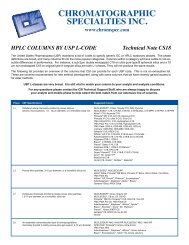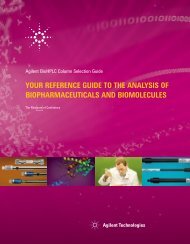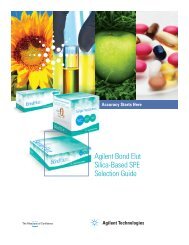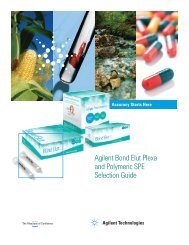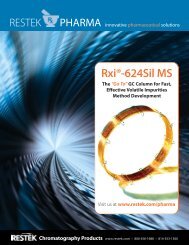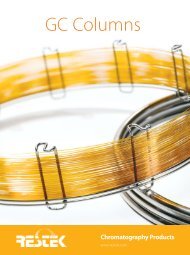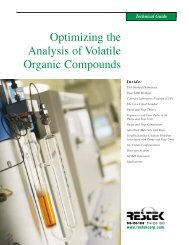You also want an ePaper? Increase the reach of your titles
YUMPU automatically turns print PDFs into web optimized ePapers that Google loves.
<strong>Aqueous</strong> <strong>and</strong> <strong>polar</strong><br />
<strong>GPC</strong>/<strong>SEC</strong> <strong>columns</strong><br />
Product guide
Contents<br />
Agilent PL aquagel-OH <strong>SEC</strong><br />
<strong>columns</strong> 3<br />
PL aquagel-OH preparative <strong>SEC</strong> <strong>columns</strong> 8<br />
Agilent PolarGel <strong>GPC</strong> <strong>columns</strong> 9<br />
PolarGel-L 10<br />
PolarGel-M 11<br />
Agilent PL Rapide 12<br />
Selection guide 14<br />
Over 30 years’ experience in <strong>GPC</strong>/<strong>SEC</strong><br />
1976<br />
PLgel <strong>columns</strong>,<br />
individual st<strong>and</strong>ards <strong>and</strong><br />
st<strong>and</strong>ard kits<br />
Polymer Laboratories<br />
founded to develop marketleading<br />
products for organic<br />
<strong>GPC</strong>/<strong>SEC</strong><br />
1981 1984 1990 1993<br />
PLgel MIXED <strong>columns</strong>,<br />
PL aquagel <strong>columns</strong><br />
MIXED <strong>columns</strong> improve<br />
data quality, <strong>and</strong> novel<br />
chemistries for analysis of<br />
water-soluble polymers<br />
<strong>GPC</strong> software<br />
Dedicated software<br />
streamlines<br />
<strong>GPC</strong>/<strong>SEC</strong> calculations<br />
2<br />
PL aquagel-OH <strong>columns</strong><br />
Vastly improve resolution<br />
<strong>and</strong> data quality in aqueous<br />
<strong>GPC</strong><br />
EasiCal st<strong>and</strong>ards<br />
New format shortens sample<br />
preparation time <strong>and</strong> the<br />
speed of calibration
Agilent PL aquagel-OH <strong>SEC</strong> <strong>columns</strong><br />
<strong>SEC</strong> with durability <strong>and</strong> versatility<br />
<strong>Aqueous</strong> size exclusion chromatography (<strong>SEC</strong>) is widely used for the<br />
determination of molecular weight distributions of a variety of synthetic<br />
<strong>and</strong> naturally occurring water soluble polymers, <strong>and</strong> separations of<br />
oligomers <strong>and</strong> small molecules. The requirement to eliminate ionic <strong>and</strong><br />
hydrophobic effects makes aqueous <strong>SEC</strong> very dem<strong>and</strong>ing.<br />
The PL aquagel-OH series provides a chemically <strong>and</strong> physically stable<br />
matrix for reliable aqueous <strong>SEC</strong> separations. The <strong>columns</strong> are packed with<br />
macroporous copolymer beads with an extremely hydrophilic polyhydroxyl<br />
functionality. The “neutral” surface <strong>and</strong> the capability to operate across<br />
a wide range of eluent conditions provide for high performance analyses<br />
of compounds with neutral, ionic <strong>and</strong> hydrophobic moieties, alone or in<br />
combination. PL aquagel-OH is available for analytical <strong>and</strong> preparative<br />
applications.<br />
1999<br />
PL-<strong>GPC</strong> 220 instrument<br />
Market-leading high<br />
temperature <strong>GPC</strong> system<br />
for routine analysis of even<br />
the most difficult samples<br />
by multi-detector <strong>GPC</strong> at<br />
temperatures up to 220 ºC<br />
2003 2004 2007 2009<br />
PL-<strong>GPC</strong> 50 instrument<br />
with light scattering <strong>and</strong><br />
viscometry<br />
Cost-effective solution to<br />
low temperature polymer<br />
analysis, including multidetector<br />
<strong>GPC</strong>/<strong>SEC</strong><br />
PlusPore <strong>columns</strong> <strong>and</strong><br />
EasiVial st<strong>and</strong>ards<br />
New chemistries deliver<br />
high-pore-volume materials<br />
for increased resolution, <strong>and</strong><br />
EasiVial st<strong>and</strong>ards simplify<br />
calibration procedures even<br />
further<br />
3<br />
PLgel Olexis <strong>columns</strong><br />
Optimized for polyolefin<br />
analysis with highest<br />
resolution <strong>and</strong> data quality<br />
for even ultrahigh molecular<br />
weight samples<br />
390-MDS Multi Detector<br />
Suite <strong>and</strong> PolarGel<br />
<strong>columns</strong><br />
The 390-MDS turns any<br />
LC into a powerful multidetector<br />
<strong>GPC</strong> system, <strong>and</strong><br />
PolarGel <strong>columns</strong> analyze<br />
<strong>polar</strong> samples in any solvent<br />
system
Agilent PL aquagel-OH <strong>SEC</strong> <strong>columns</strong><br />
Optimizing conditions for aqueous sec with PL aquagel-OH<br />
<strong>columns</strong><br />
Due to the complex nature of water soluble polymers, it is often necessary<br />
to modify the eluent in order to avoid sample-to-sample <strong>and</strong> sample-tocolumn<br />
interactions which can result in poor aqueous <strong>SEC</strong> separations.<br />
The excellent stability of the PL aquagel-OH packing material allows the<br />
eluent to be tailored to suit the polymer, while retaining the high column<br />
efficiency. For ionic interactions, the eluent can be modified by the<br />
addition of salt <strong>and</strong>/or the adjustment of pH. For water soluble polymers<br />
with a hydrophobic character, only the addition of a weak organic solvent<br />
(methanol) is required to inhibit hydrophobic interactions.<br />
• PL aquagel-OH Analytical Columns – Available with mixed <strong>and</strong><br />
individual pore sizes, <strong>and</strong> 5, 8 <strong>and</strong> 15 µm particle sizes, to cover a very<br />
wide range of molecular weights.<br />
• PL aquagel-OH Preparative Columns – For rapid <strong>and</strong> convenient<br />
scale-up from analytical separations. The <strong>columns</strong> are packed with the<br />
same robust macroporous particles as the analytical column range<br />
PL aquagel-OH column selection guide<br />
Sample type Typical applications Recommended column sets<br />
Low MW polymers <strong>and</strong> oligomers Surfactants, oligosaccharides, PEGs,<br />
lignosulfonates, polyacrylates<br />
Polydisperse synthetic or<br />
naturally occurring polymers<br />
Polysaccharides, PVA, cellulose derivatives,<br />
PEO, polyacrylic acid<br />
Very high MW polymers Polyacrylamides, hyaluronic acids, CMC,<br />
starches, gums<br />
Tip: When using a set of <strong>columns</strong> containing different pore sizes, put<br />
the highest pore size first to reduce the viscosity in the system as<br />
early as possible to improve column lifetimes.<br />
4<br />
Polymer<br />
Chemistry<br />
Suggested<br />
Eluent<br />
Hydrophobic<br />
Polymers<br />
Neutral<br />
Pure water<br />
Water soluble polymer<br />
Addition of up to 50% methanol<br />
Figure 1. Guide to eluent selection for PL aquagel-OH applications<br />
Anionic Cationic<br />
0.1-0.3M<br />
NaNO3 pH 7 - 9<br />
0.01M<br />
NaH2PO4 Set of 2 or 3 PL aquagel-OH 30/20<br />
PL aquagel-OH 8 µm, or<br />
PL aquagel-OH 20 5 µm, or<br />
PL aquagel-OH MIXED-M 8 µm<br />
2 or 3<br />
PL aquagel-OH MIXED-H 8 µm, or<br />
PL aquagel-OH 60/50/40 8 µm<br />
PL aquagel-OH 60/50/40 15 µm in series<br />
0.2-0.8M<br />
NaNO3 pH 2-7<br />
0.01M<br />
NaH2PO4
PL aquagel-OH <strong>SEC</strong> <strong>columns</strong><br />
High performance aqueous size<br />
exclusion chromatography<br />
• Highly stable matrix ensures reliable separations, even with modified<br />
eluents<br />
• MIXED <strong>columns</strong> cover a wide spread of molecular weights, simplifying<br />
column selection<br />
• Highly versatile for neutral, <strong>polar</strong>, anionic <strong>and</strong> cationic samples<br />
The PL aquagel-OH analytical series has a pH range 2 – 10, compatibility<br />
with organic solvent (up to 50% methanol), mechanical stability up to 140<br />
bar (2030 psi) <strong>and</strong> low column operating pressures.<br />
PL aquagel-OH MIXED 8 µm <strong>columns</strong> offer high resolution over a very wide<br />
range of molecular weight, simplifying column selection <strong>and</strong> providing a<br />
versatile analytical system.<br />
PL aquagel-OH 20 5 µm <strong>columns</strong> are ideal for analysis of low MW<br />
polymers. The ‘20’ column ensures maximum resolution for the analysis of<br />
low viscosity samples.<br />
PL aquagel-OH 30 8 µm <strong>columns</strong> separate relatively low MW polymers,<br />
combining low exclusion limit, high pore volume <strong>and</strong> high column efficiency<br />
for maximum resolution.<br />
PL aquagel-OH Individual Pore Size 8 µm <strong>columns</strong> are designed<br />
for high performance separations from 10,000 to >10,000,000. (g/mol<br />
PEG/PEO equiv.).<br />
PL aquagel-OH 15 µm <strong>columns</strong> analyze very high MW polymers. Where<br />
molecular shear degradation is a consideration, the larger particle size <strong>and</strong><br />
larger frit porosity permit the analysis of high viscosity polymers from 1M<br />
to 100M.<br />
For molecular weight ranges of these <strong>columns</strong>, see page 7.<br />
Tip Buffers in a stored column may crystallize out <strong>and</strong> cause damage,<br />
so flush out the column with water containing a small amount of<br />
sodium azide, to prevent biological growth.<br />
5<br />
Figure 2. PL aquagel-OH calibration curves
PL aquagel-OH <strong>SEC</strong> <strong>columns</strong><br />
Typical applications<br />
Heparin, gum, polyacrylic acid, polyacrylamide, pectin, dextran<br />
Conditions<br />
Columns: 3 x PL aquagel-OH MIXED 8 µm,<br />
300 x 7.5 mm<br />
Eluent: 0.2 M NaNO 3, 0.01 M<br />
NaH 2PO 4, pH 7<br />
Flow Rate: 1.0 mL/min<br />
Detector: PL-<strong>GPC</strong> 50 (RI)<br />
Figure 3. Polyvinyl alcohol<br />
Conditions<br />
Columns: 2 x PL aquagel-OH 30 8 µm, 300 x 7.5 mm<br />
Eluent: 0.2 M NaNO 3, 0.01M NaH 2PO 4, pH 7<br />
Flow Rate: 1.0 mL/min<br />
Detector: PL-<strong>GPC</strong> 50 (RI)<br />
Figure 4. Heparin<br />
6<br />
Conditions<br />
Columns: PL aquagel-OH 60 15 µm, 300 x 7.5 mm<br />
PL aquagel-OH 40 15 µm, 300 x 7.5 mm<br />
Eluent: 0.2 M NaNO3, 0.01 M NaH2PO4, pH 7<br />
Flow Rate: 1.0 mL/min<br />
Detector: PL-<strong>GPC</strong> 50 (RI)<br />
Figure 5. Hyaluronic acid<br />
Conditions<br />
Columns: 2 x PL aquagel-OH 20 5 µm, 300 x 7.5 mm<br />
Eluent: 0.25 M ammonium formate in water<br />
Flow Rate: 1.0 mL/min<br />
Inj. Vol: 20 µL<br />
Software: Agilent Cirrus <strong>GPC</strong> module for Agilent ChemStation CDS<br />
Detector: Agilent ELS (neb = 30 °C, evap = 30 °C, gas = 1.4 SLM)<br />
Figure 6. Differences in composition of two alkyl naphthalene sulfonates
PL aquagel-OH <strong>SEC</strong> <strong>columns</strong><br />
Ordering information<br />
PL aquagel-OH Columns, 300 x 7.5 mm<br />
Description Particle size (µm) MW range (g/mol) (PEG/PEO) Guaranteed Efficiency<br />
(p/m)<br />
Part No.<br />
PL aquagel-OH 20 5 100 to 10,000 >55,000 PL1120-6520<br />
PL aquagel-OH 30 8 100 to 30,000 >35,000 PL1120-6830<br />
PL aquagel-OH 40 8 10,000 to 200,000 >35,000 PL1149-6840<br />
PL aquagel-OH 40 15 10,000 to 200,000 >15,000 PL1149-6240<br />
PL aquagel-OH 50 8 50,000 to 1,000,000 >35,000 PL1149-6850<br />
PL aquagel-OH 50 15 50,000 to 1,000,000 >15,000 PL1149-6250<br />
PL aquagel-OH 60 8 200,000 to >10,000,000 >35,000 PL1149-6860<br />
PL aquagel-OH 60 15 200,000 to >10,000,000 >15,000 PL1149-6260<br />
PL aquagel-OH MIXED-H 8 100 to 10,000,000 >35,000 PL1149-6800<br />
PL aquagel-OH MIXED-M 8 >600,000 >35,000 PL1149-6801<br />
Ordering information<br />
PL aquagel-OH Analytical Column accessories<br />
Description Quantity<br />
(pk)<br />
Part No.<br />
Frit Removal Tool for Threaded Columns only 1 PL1310-0001<br />
Frit (2 µm) Kit for Threaded Columns,<br />
7.5 mm ID<br />
Frit (5 µm) Kit for Threaded Columns,<br />
7.5 mm ID<br />
5 PL1310-0002<br />
5 PL1310-0012<br />
Column Connecting Nuts, 1/16 in. Tube 5 PL1310-0007<br />
Tubing Ferrules, 1/16 in. Tube 5 PL1310-0008<br />
LDV Intercolumn SS Connector 1 PL1310-0005<br />
Connecting Tubing, 10 cm length, 0.01 in. ID 10 PL1310-0048<br />
See also<br />
• Polymer Calibration St<strong>and</strong>ards, with highly characterized molecular<br />
weights, publication 5990-7996EN<br />
7<br />
Ordering information<br />
PL aquagel-OH Guard Columns<br />
Description Particle<br />
size (µm)<br />
ID<br />
(mm)<br />
Length<br />
(mm)<br />
Part No.<br />
PL aquagel-OH Guard 10 25.0 25 PL1249-1120<br />
PL aquagel-OH Guard 5 7.5 50 PL1149-1530<br />
PL aquagel-OH Guard 8 7.5 50 PL1149-1840
PL aquagel-OH preparative <strong>SEC</strong> <strong>columns</strong><br />
Rapid <strong>and</strong> convenient scale-up<br />
• Up to 10 x scale-up maximizes yield<br />
• High loading maximizes sample throughput<br />
• Carefully chosen particle size provides optimum resolution<br />
Preparative <strong>SEC</strong> is used for the fractionation of a wide variety of water<br />
soluble samples based on their size in solution. The technique is applied<br />
to the fractionation of disperse polymers or to isolate components in a<br />
polymer formulation.<br />
Preparative PL aquagel-OH <strong>columns</strong> <strong>and</strong> associated guard <strong>columns</strong> enable<br />
rapid <strong>and</strong> convenient scale-up from analytical separations. The 25 mm ID<br />
prep column offers at least a x10 scale-up in loading from the 7.5 mm ID<br />
analytical <strong>columns</strong>. Typically, a 10 mL/min flow rate results in a separation<br />
time of ten minutes with a 300 mm column. The <strong>columns</strong> are packed with<br />
the same robust macroporous particles as the analytical column range. The<br />
8 µm particle size provides optimum resolution <strong>and</strong> loading characteristics<br />
with column efficiency >20,000 plates/m.<br />
See also<br />
• Polymer Calibration St<strong>and</strong>ards, with highly characterized molecular<br />
weights, publication 5990-7996EN<br />
Ordering information<br />
PL aquagel-OH Preparative Columns 8 µm, 300 x 25 mm<br />
Description MW range<br />
(g/mol)<br />
(PEG/PEO)<br />
Part No.<br />
PL aquagel-OH 30 100 to 30,000 PL1220-6130<br />
PL aquagel-OH 40 10,000 to 200,000 PL1249-6140<br />
PL aquagel-OH 50 50,000 to 1,000,000 PL1249-6150<br />
PL aquagel-OH MIXED 100 to 10,000,000 PL1249-6100<br />
PL aquagel-OH Guard, 25 x 25 mm PL1249-1120<br />
8<br />
Typical applications<br />
Fractionation of disperse polymers, component isolation<br />
Conditions<br />
Column: PL aquagel-OH 40 8 µm, 300 x 25 mm<br />
Eluent: 0.2M NaNO 3, 0.01M NaH 2PO 4, pH 7<br />
Flow Rate: 10.0 mL/min<br />
Loading: 10 mg/mL, 2 mL<br />
Detector: PL-<strong>GPC</strong> 50 (RI)<br />
Figure 7. Polyvinyl alcohol
Agilent PolarGel <strong>GPC</strong> <strong>columns</strong><br />
For intermediate <strong>polar</strong>ity solvents <strong>and</strong><br />
<strong>polar</strong> solvent combinations<br />
The PolarGel range is ideal for use with <strong>polar</strong> solvents, for example<br />
dimethyl formamide <strong>and</strong> dimethyl sulfoxide, <strong>and</strong> for solvent combinations<br />
such as tetrahydrofuran with water. These eluents are very useful in<br />
<strong>GPC</strong>/<strong>SEC</strong> to separate <strong>polar</strong> materials, such as <strong>polar</strong> resins, modified<br />
polysaccharides or complex <strong>polar</strong> polymers that are difficult to analyze in<br />
traditional <strong>SEC</strong> solvents, such as tetrahydrofuran alone. PolarGel-L is used<br />
for low molecular weight <strong>polar</strong> polymers <strong>and</strong> PolarGel-M for high MW<br />
<strong>polar</strong> polymers.<br />
With <strong>polar</strong> polymers, highly <strong>polar</strong> groups can lead to non-specific<br />
interactions <strong>and</strong> secondary separation mechanisms when using <strong>polar</strong><br />
solvents <strong>and</strong> traditional non-<strong>polar</strong> styrene/divinylbenzene <strong>columns</strong>.<br />
Additives <strong>and</strong>/or column conditioning are normally required to reduce<br />
these interactions. PolarGel has no need for these interventions, <strong>and</strong> also<br />
avoids the interactions <strong>and</strong> secondary effects that produce chromatogram<br />
distortions.<br />
These PolarGel “mixed bed” <strong>columns</strong> have a medium <strong>polar</strong>ity surface <strong>and</strong><br />
high mechanical stability. They are capable of operating in a wide range<br />
of solvents <strong>and</strong> solvent combinations, greatly enhancing your ability to<br />
analyze <strong>polar</strong> polymers that are not necessarily water soluble. PolarGel is<br />
available in two resolving ranges to meet your precise requirements.<br />
Charateristics<br />
PolarGel-L<br />
Particle Size: 8 µm<br />
Resolving Range (PEG/PEO in water): Up to 30,000 g/mol<br />
PolarGel-M<br />
Particle Size: 8 µm<br />
Resolving Range (PEG/PEO in water): Up to 700,000 g/mol<br />
9<br />
Conditions<br />
Columns: 2 x PolarGel-M, 300 x 7.5 mm<br />
Sample: Melamine resins<br />
Eluent: Dimethylformamide + 0.1% LiBr<br />
Flow Rate: 1.0 mL/min<br />
Temp: 50 °C<br />
Detector: PL-<strong>GPC</strong> 50 (RI)<br />
Figure 8. Superior <strong>polar</strong> performance from PolarGel <strong>columns</strong>
PolarGel-L<br />
For analysis of low molecular weight<br />
polymers in <strong>polar</strong> solvents<br />
• Specifically designed for <strong>polar</strong> samples<br />
• Mixed bed technology delivers near linear calibrations for greater<br />
accuracy<br />
• Mechanical stability for longer column lifetimes<br />
See also<br />
• EasiVial PEG/PEO <strong>and</strong> PMMA St<strong>and</strong>ards, pre-weighed to save time,<br />
publication 5990-7996EN<br />
<strong>GPC</strong>/<strong>SEC</strong><br />
st<strong>and</strong>ards<br />
Product guide<br />
10<br />
Typical applications<br />
Melamines, <strong>polar</strong> resins <strong>and</strong> <strong>polar</strong> pre-polymers<br />
Conditions<br />
Columns: 2 x PolarGel-L, 300 x 7.5 mm<br />
Eluent: Dimethylacetamide + 0.1% LiBr<br />
Flow Rate: 1.0 mL/min<br />
Inj Vol: 100 µL<br />
Temp: 50 °C<br />
Detector: PL-<strong>GPC</strong> 50 (RI)<br />
Figure 9. Two samples of melamine resin analyzed by PolarGel-L<br />
Ordering information<br />
PolarGel-L Columns<br />
Description Part No.<br />
PolarGel-L, 300 x 7.5 mm PL1117-6830<br />
Frit Removal Tool for Threaded Columns only PL1310-0001<br />
End Fitting for Threaded Columns, 7.5 mm ID PL1310-0004<br />
Frit (5 µm) Kit for Threaded Columns, 7.5 mm ID (5/pk) PL1310-0012<br />
Column Connecting Nuts (Pk of 5), 1/16 in. (5/pk) PL1310-0007<br />
Tubing Ferrules (Pk of 5), 1/16 in. (5/pk) PL1310-0008<br />
Column End Plugs (Pk of 10), 1/16 in. (10/pk) PL1310-0003<br />
LDV Intercolumn SS Connector PL1310-0005<br />
PolarGel-L Repair Gel PL1417-0830<br />
PolarGel-L Guard Column, 50 x 7.5 mm PL1117-1830
PolarGel-M<br />
For analyzing a wide range of polymers<br />
in <strong>polar</strong> solvents<br />
• Optimized pore size distribution <strong>and</strong> particle size for superior resolution<br />
• Mixed bed technology simplifies column selection<br />
• No sample <strong>and</strong> stationary phase interaction for accurate MW<br />
measurement<br />
See also<br />
• EasiVial PEG/PEO <strong>and</strong> PMMA St<strong>and</strong>ards, pre-weighed to save time,<br />
publication 5990-7996EN<br />
Ordering information<br />
PolarGel-M Columns<br />
Description Part No.<br />
PolarGel-M, 300 x 7.5 mm PL1117-6800<br />
Frit Removal Tool for Threaded Columns only PL1310-0001<br />
End Fitting for Threaded Columns, 7.5 mm ID PL1310-0004<br />
Frit (5 µm) Kit for Threaded Columns, 7.5 mm ID (5/pk) PL1310-0012<br />
Column Connecting Nuts, 1/16 in. Tube (5/pk) PL1310-0007<br />
Tubing Ferrules, 1/16 in. Tube (5/pk) PL1310-0008<br />
Column End Plugs, 1/16 in. (10/pk) PL1310-0003<br />
LDV Intercolumn SS Connector PL1310-0005<br />
PolarGel-M Repair Gel PL1417-0800<br />
PolarGel-M Guard Column, 50 x 7.5 mm PL1117-1800<br />
Tip: Filter samples through a 0.45 µm filter prior to injection to extend<br />
column lifetime.<br />
11<br />
Typical applications<br />
Phenol formaldehyde resins <strong>and</strong> lignins<br />
Conditions<br />
Columns: 2 x PolarGel-M, 300 x 7.5 mm<br />
Eluent: 0.2% (w/v) DMF & 0.1% LiBr to reduce sample aggregation<br />
Flow Rate: 1.0 mL/min<br />
Inj Vol: 100 µL<br />
Temp: 50 °C<br />
Detector: PL-<strong>GPC</strong> 50 (RI)<br />
Figure 10. Excellent separation of two phenol formaldehyde resins with PolarGel-M
Agilent PL Rapide<br />
Fast separations for high turnaround or<br />
when analyzing many samples<br />
• Analysis of water-soluble polymers in less than ten minutes saves time<br />
• Significantly increased sample throughput improves efficiency<br />
• Reduced solvent consumption <strong>and</strong> disposal costs saves money<br />
Two key parameters can be varied to reduce the analysis time of an<br />
experiment. Column length can be reduced or eluent flow rate increased.<br />
Using both methods, PL Rapide <strong>columns</strong> provides significantly increased<br />
sample throughput compared to a conventional <strong>GPC</strong>/<strong>SEC</strong> column set.<br />
Rapid <strong>GPC</strong> is an excellent tool for screening polymer MWD for trend<br />
analysis. Short PL Rapide <strong>columns</strong> reduce analysis times while maintaining<br />
the excellent solvent compatibility <strong>and</strong> mechanical stability of all <strong>GPC</strong><br />
<strong>columns</strong> from Agilent.<br />
Ordering information<br />
PL Rapide Columns<br />
Description MW range (g/mol) Guaranteed efficiency (p/m) Part No.<br />
PL Rapide Aqua H, 150 x 7.5 mm 100 to 10,000,000 >35,000 PL1149-3800<br />
PL Rapide Aqua H, 100 x 10 mm 100 to 10,000,000 >35,000 PL1049-2800<br />
PL Rapide Aqua L, 150 x 7.5 mm 100 to 30,000 >35,000 PL1120-3830<br />
PL Rapide Aqua L, 100 x 10 mm 100 to 30,000 >35,000 PL1020-2830<br />
12<br />
PL Rapide <strong>columns</strong> are ideal for high speed applications such as high<br />
throughput screening, process monitoring, or tracking changes in MW<br />
distributions, where time is the most critical factor in the analysis. Packed<br />
with high quality gels, these <strong>columns</strong> cover the complete spectrum of<br />
molecular weights <strong>and</strong> are available for the analysis of water soluble<br />
polymers. Key features include high pore volume <strong>and</strong> high resolution<br />
packing materials, no special system requirements, choice of molecular<br />
weight resolving range, wide solvent compatibility, <strong>and</strong> excellent<br />
mechanical stability.<br />
PL Rapide is available in L <strong>and</strong> H versions for low<strong>and</strong> high molecular<br />
weights.
Typical applications<br />
Sodium acrylate<br />
Conditions<br />
Column: PL Rapide Aqua H, 150 x 7.5 mm<br />
Eluent: Water + 0.2 M NaNO 3, 0.01 M NaH 2PO 4, pH 7<br />
Flow rate: 1.0 mL/min<br />
Detector: PL-<strong>GPC</strong> 50<br />
Figure 11. Sodium acrylate<br />
13<br />
See also<br />
• More PL Rapide <strong>columns</strong> <strong>and</strong> applications, publication 5990-7994EN<br />
Organic<br />
<strong>GPC</strong>/<strong>SEC</strong> <strong>columns</strong><br />
Product guide
Selection guide<br />
<strong>GPC</strong> <strong>and</strong> <strong>SEC</strong> are liquid<br />
chromatographic techniques that<br />
separate individual polymer chains on<br />
the basis of their size in solution <strong>and</strong><br />
not on their chemistry.<br />
Gel permeation chromatography (<strong>GPC</strong>) <strong>and</strong> size exclusion chromatography<br />
(<strong>SEC</strong>) are techniques for measuring the molecular weight distribution<br />
of natural <strong>and</strong> synthetic polymers, a property that affects many of the<br />
physical parameters of materials such as strength, toughness <strong>and</strong> chemical<br />
resistance.<br />
We use <strong>GPC</strong> to describe the analysis of polymers in organic solvents, such<br />
as tetrahydrofuran, <strong>and</strong> <strong>SEC</strong> to describe the analysis of polymers in water<br />
<strong>and</strong> water-based solvents, such as buffer solutions. <strong>GPC</strong>/<strong>SEC</strong> is the only<br />
established method for obtaining a comprehensive underst<strong>and</strong>ing of a<br />
polymer’s molecular weight distribution.<br />
How to use this selection guide<br />
There are many <strong>columns</strong> available for the analysis of polymers by <strong>GPC</strong>/<br />
<strong>SEC</strong>. The purpose of this guide is to help you find a set of <strong>columns</strong> <strong>and</strong><br />
conditions for the analysis of most common polymer types. A series of<br />
questions helps to narrow the choice down to the appropriate set. Some<br />
applications are not so easy to define <strong>and</strong> the required information may not<br />
be known, so consult your local expert in <strong>GPC</strong>/<strong>SEC</strong><br />
for advice.<br />
Mechanisms of <strong>GPC</strong>/<strong>SEC</strong><br />
• Polymer molecules dissolve in solution to form spherical coils with size<br />
dependent on molecular weight<br />
• Polymer coils introduced to eluent flowing through a column<br />
• Column packed with insoluble porous beads with well-defined pore<br />
structure<br />
• Size of pores similar to that of polymer coils<br />
• Polymer coils diffuse in <strong>and</strong> out of the pores<br />
• Result is elution based on size – large coils first, smaller coils last<br />
• Size separation converted to molecular weight separation by use of a<br />
calibration curve constructed by the use of polymer st<strong>and</strong>ards<br />
14<br />
Figure 12. Mechanism of Gel Permeation Chromatography/Size Exclusion Chromatography<br />
(<strong>GPC</strong>/<strong>SEC</strong>)
Recommendations for setting up a <strong>GPC</strong>/<strong>SEC</strong> system<br />
The following questions will help you find the recommended <strong>columns</strong> <strong>and</strong> st<strong>and</strong>ards for any given application, as well as system parameters such as<br />
injection volumes.<br />
Choosing an eluent for <strong>GPC</strong>/<strong>SEC</strong><br />
Question Answer Recommendation Comments<br />
1. What is the sample soluble in?<br />
Many polymers are only soluble in a small<br />
number of solvents. This is the key question when<br />
developing methods for analyzing polymers. The<br />
solvents mentioned here are all common eluents<br />
employed in <strong>GPC</strong>/<strong>SEC</strong>.<br />
Choosing a column for <strong>GPC</strong>/<strong>SEC</strong><br />
Water or water<br />
buffer with up to<br />
50% methanol<br />
Organic/water<br />
mixtures or <strong>polar</strong><br />
organics such as,<br />
DMF, NMP<br />
(Covered in the<br />
Organic <strong>GPC</strong>/<strong>SEC</strong><br />
<strong>columns</strong> guide,<br />
publication<br />
5990-7994EN)<br />
Agilent PL aquagel-OH Best choice for water-based applications but cannot<br />
accommodate organics apart from methanol up to 50%<br />
Agilent PolarGel PolarGel is a smaller column range than PLgel or<br />
PL aquagel-OH <strong>columns</strong> but is suited to mixtures<br />
of organics <strong>and</strong> water<br />
Question Answer Recommendation Comments<br />
2. What is the expected<br />
molecular weight?<br />
It may seem strange to ask this question, but in<br />
<strong>GPC</strong>/<strong>SEC</strong> the resolution of a column is related to<br />
the resolving range. Knowing something of the<br />
expected molecular weight of a sample helps to<br />
choose the best column that will give optimum<br />
results.<br />
High (up to several<br />
millions)<br />
Intermediate (up<br />
to hundreds of<br />
thous<strong>and</strong>s)<br />
Low (up to tens of<br />
thous<strong>and</strong>s)<br />
Very low (a few<br />
thous<strong>and</strong>)<br />
<strong>Aqueous</strong> solvents<br />
PL aquagel-OH MIXED-H<br />
8 µm<br />
or combination of<br />
PL aquagel-OH 40 <strong>and</strong> 60<br />
15 µm<br />
Mixed solvents<br />
PolarGel<br />
<strong>Aqueous</strong> solvents<br />
PL aquagel-OH MIXED-M<br />
8 µm<br />
Mixed solvents<br />
PolarGel-M<br />
<strong>Aqueous</strong> solvents<br />
Combination of PL aquagel-<br />
OH 40 <strong>and</strong> PL aquagel-OH<br />
30 8 µm<br />
Mixed solvents<br />
PolarGel-L<br />
<strong>Aqueous</strong> solvents<br />
PL aquagel-OH 20 5 µm<br />
Mixed solvents<br />
PLgel<br />
Unknown <strong>Aqueous</strong> solvents<br />
PL aquagel-OH MIXED-M<br />
8 µm<br />
Mixed solvents<br />
PolarGel-M<br />
15<br />
The 15 µm column combination is best only where sample<br />
viscosity is very high, otherwise 8 µm <strong>columns</strong> give<br />
greater resolution<br />
No PolarGel column available for this molecular weight range.<br />
Contact your local <strong>GPC</strong>/<strong>SEC</strong> expert for advice<br />
A wide-ranging column that covers most water-soluble<br />
polymers<br />
Covers most applications<br />
These two <strong>columns</strong> in a combined set cover the low end<br />
of the molecular weight range<br />
For low molecular weight applications<br />
This high-performance column gives high resolution at<br />
low molecular weight<br />
No PolarGel column covers this range so use PLgel <strong>columns</strong><br />
as alternatives<br />
Covers the molecular weight ranges of most polymer samples<br />
Covers the majority of applications
Setting up the <strong>GPC</strong>/<strong>SEC</strong> system<br />
Question Answer Recommendation Comments<br />
3. How many <strong>columns</strong> to use?<br />
The greater the particle size of the media<br />
in the column (which is dependent on the<br />
expected molecular weight of the samples),<br />
the lower the resolution <strong>and</strong> the more<br />
<strong>columns</strong> are required to maintain the quality<br />
of the results. For higher molecular weight<br />
samples, larger particles are necessary to<br />
reduce the danger of shear degradation of<br />
samples during analysis.<br />
Depends on the particle size<br />
of the <strong>columns</strong><br />
16<br />
Particle size 20 µm<br />
use 4 <strong>columns</strong><br />
Particle size 13 µm<br />
use 3 <strong>columns</strong><br />
Particle size 10 µm<br />
use 3 <strong>columns</strong><br />
Particle size 8 µm<br />
use 2 <strong>columns</strong><br />
Particle size 5 µm<br />
use 2 <strong>columns</strong><br />
Particle size 3 µm<br />
use 2 <strong>columns</strong><br />
Question Answer Recommendation Comments<br />
4. What size injection volume?<br />
The injection volume required is dependent<br />
on the particle size of the column –<br />
smaller particles need lower injection<br />
volumes to minimize dead volume. Larger<br />
injection volumes allow the introduction<br />
of high molecular weight samples at lower<br />
concentrations, reducing viscosity <strong>and</strong><br />
ensuring a quality chromatogram is obtained.<br />
Depends on the particle size<br />
of the <strong>columns</strong><br />
Particle size 20 µm<br />
use 200 µL injection<br />
Particle size 13 µm<br />
use 200 µL injection<br />
Particle size 10 µm<br />
use 200 µL injection<br />
Particle size 5 µm<br />
use 100 to 200 µL injection<br />
Particle size 3 µm<br />
use 20 µL injection<br />
Increased number of <strong>columns</strong> required for large<br />
particle sizes to make up for low efficiencies<br />
Smaller particle sizes require smaller loops to minimize<br />
b<strong>and</strong> broadening
Typical polymer molecular weights<br />
If you are unsure of the molecular weight of your sample, the table below shows some approximate molecular weight ranges for common polymers, which<br />
will help you select the right column for your application.<br />
Polymer Type Typical molecular weight of polymer Typical polydispersity 1 of polymer<br />
Polymers from free radical synthesis High (up to several millions) ~ 2<br />
Intermediate (up to hundreds of thous<strong>and</strong>s)<br />
Polymers from ionic synthesis Intermediate (up to hundreds of thous<strong>and</strong>s) ~ 1.01<br />
Low (up to tens of thous<strong>and</strong>s)<br />
Polymers from addition synthesis Intermediate (up to hundreds of thous<strong>and</strong>s) ~ 2<br />
Low (up to tens of thous<strong>and</strong>s)<br />
Polymers from controlled radical polymerization Low (up to tens of thous<strong>and</strong>s) ~ 1.1 to 1.5<br />
Very low (a few thous<strong>and</strong>)<br />
Small molecule additives Very low (a few thous<strong>and</strong>) 1<br />
Pre-polymers Low (up to tens of thous<strong>and</strong>s) ~ 2 to 10<br />
Very low (a few thous<strong>and</strong>)<br />
Natural biopolymers such as polysaccharides Intermediate (up to hundreds of thous<strong>and</strong>s) ~ 2 to 10<br />
High (up to several millions)<br />
Biodegradable polymers Intermediate (up to hundreds of thous<strong>and</strong>s) ~ 1.1 to 2<br />
Low (up to tens of thous<strong>and</strong>s)<br />
1 Polydispersity is a measure of the distribution of molecular mass of a polymer (Mw/Mn)<br />
17
Further reading<br />
<strong>GPC</strong>/<strong>SEC</strong> publication Publication number<br />
Application compendia<br />
Excipient analysis by <strong>GPC</strong>/<strong>SEC</strong> <strong>and</strong> other LC techniques 5990-7771EN<br />
Biodegradable polymers - analysis of biodegradable polymers by <strong>GPC</strong>/<strong>SEC</strong> 5990-6920EN<br />
Analysis of engineering polymers by <strong>GPC</strong>/<strong>SEC</strong> 5990-6970EN<br />
Analysis of elastomers by <strong>GPC</strong>/<strong>SEC</strong> 5990-6866EN<br />
Analysis of polyolefins by <strong>GPC</strong>/<strong>SEC</strong> 5990-6971EN<br />
Low molecular weight resins - Analysis of low molecular weight resins <strong>and</strong> prepolymers by <strong>GPC</strong>/<strong>SEC</strong><br />
Primer<br />
5990-6845EN<br />
An Introduction to Gel Permeation Chromatography <strong>and</strong> Size Exclusion Chromatography<br />
Selection guide<br />
5990-6969EN<br />
Quick guide for selecting <strong>columns</strong> <strong>and</strong> st<strong>and</strong>ards for gel permeation chromatography <strong>and</strong> size exclusion chromatography<br />
Wallchart<br />
5990-6868EN<br />
<strong>GPC</strong>/<strong>SEC</strong> Reference Guide<br />
Product guides<br />
5990-6882EN<br />
Organic <strong>GPC</strong>/<strong>SEC</strong> <strong>columns</strong> 5990-7994EN<br />
<strong>GPC</strong>/<strong>SEC</strong> st<strong>and</strong>ards 5990-7996EN<br />
To download these publications visit www.agilent.com/chem/gpcsec<br />
18
Agilent <strong>GPC</strong>/<strong>SEC</strong> Analysis Systems<br />
For easy <strong>and</strong> reliable polymer characterization, turn to the Agilent 1260<br />
Infinity <strong>GPC</strong>/<strong>SEC</strong> Analysis System. The isocratic solvent delivery system<br />
provides the constant, stable flow rate that is essential to maintain the<br />
high resolution of the <strong>GPC</strong>/<strong>SEC</strong> column. And with its high flow precision<br />
<strong>and</strong> excellent temperature stability, you can be confident of the highest<br />
accuracy <strong>and</strong> precision for your molecular weight determinations.<br />
Agilent 1260 Infinity <strong>GPC</strong>/<strong>SEC</strong> Analysis System<br />
19<br />
The Agilent PL-<strong>GPC</strong> 50 Integrated <strong>GPC</strong>/<strong>SEC</strong> System is a st<strong>and</strong>alone<br />
instrument containing all the components necessary for the analysis of<br />
a wide range of polymers. With pump, injection valve, column oven <strong>and</strong><br />
optional degasser, as well as any combination of refractive index, light<br />
scattering <strong>and</strong> viscometry detectors, the PL-<strong>GPC</strong> 50 is an ideal choice when<br />
you are starting out in <strong>GPC</strong> or want the convenience of a single solution.<br />
Agilent PL-<strong>GPC</strong> 50 Integrated <strong>GPC</strong>/<strong>SEC</strong> System
Learn more<br />
www.agilent.com/chem<br />
Buy online<br />
www.agilent.com/chem/store<br />
Find an Agilent office or authorized distributor<br />
www.agilent.com/chem/contactus<br />
U.S. <strong>and</strong> Canada<br />
1-800-227-9770, agilent_inquiries@agilent.com<br />
Europe<br />
info_agilent@agilent.com<br />
Asia Pacific<br />
inquiry_lsca@agilent.com<br />
India<br />
india-lsca_marketing@agilent.com<br />
Agilent shall not be liable for errors contained herein or for incidental<br />
or consequential damages in connection with the furnishing,<br />
performance, or use of this material.<br />
Information, descriptions, <strong>and</strong> specifications in this publication<br />
are subject to change without notice.<br />
© Agilent Technologies, Inc., 2011<br />
Published in the USA, July 11, 2011<br />
Publication Number 5990-7995EN





